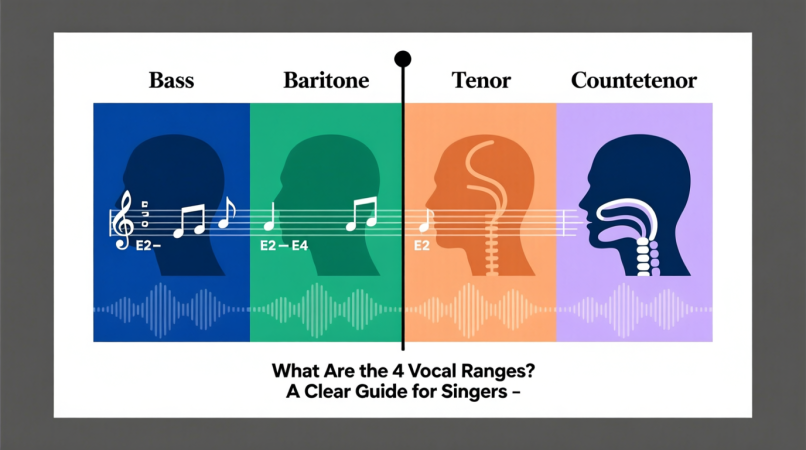
If you’ve ever listened to a choir, opera, or even a pop performance, you’ve probably noticed how voices sound different—some soar high and light, others resonate deep and low. These differences are organized into categories called vocal ranges. Traditionally, there are four main ones: soprano, alto, tenor, and bass.
In this guide, we’ll break down what each of these ranges means, show their typical spans, and explain why they matter for singers and listeners alike.
Why Vocal Ranges Matter
Vocal ranges aren’t just labels. They:
- Help singers understand their comfortable singing limits.
- Allow choirs and ensembles to blend harmoniously.
- Provide a framework for both classical and modern music.
Most singers fit somewhere into the four standard categories, but many voices overlap. That’s why range is better seen as a spectrum than rigid boxes.
The 4 Main Vocal Ranges
1. Soprano – The Highest Female Voice
- Range (approx): C4 to C6
- Tone: Light, bright, and capable of cutting through orchestras
- Role: Frequently leads the melody line in ensembles
- Examples: Whitney Houston (pop), Renée Fleming (opera)
2. Alto – The Lower Female Voice
- Range (approx): F3 to F5
- Tone: Darker, fuller, often supporting harmonies
- Role: Provides depth and balance to sopranos in choirs
- Examples: Adele, Amy Winehouse
If you’re curious about how this range compares with others, check our full guide on the alto and baritone range differences for a side-by-side look.
3. Tenor – The Higher Male Voice
- Range (approx): C3 to B4
- Tone: Bright, expressive, often associated with emotional delivery
- Role: Dominant in many operas and pop ballads
- Examples: Freddie Mercury, Pavarotti, Sam Smith
4. Bass – The Lowest Male Voice
- Range (approx): E2 to E4
- Tone: Resonant, commanding, rich
- Role: Forms the harmonic foundation in most ensembles
- Examples: Barry White, Avi Kaplan
Quick Reference Table
| Voice Type | Typical Range | Famous Examples |
|---|---|---|
| Soprano | C4 – C6 | Whitney Houston, Renée Fleming |
| Alto | F3 – F5 | Adele, Amy Winehouse |
| Tenor | C3 – B4 | Freddie Mercury, Pavarotti |
| Bass | E2 – E4 | Barry White, Avi Kaplan |
Beyond the Four Ranges
While SATB (soprano, alto, tenor, bass) is the classical framework, reality is more fluid. Some important subcategories include:
- Mezzo-Soprano: Between soprano and alto
- Contralto: The rare, lowest female voice
- Baritone: The most common male voice, between tenor and bass
- Countertenor: A male singer with a range similar to alto
How to Discover Your Range
Want to figure out where your own voice fits? Here’s a simple method:
- Start from a comfortable middle note (like middle C).
- Sing downward step by step until your tone breaks.
- Do the same upward until you can’t sing without strain.
- Note the lowest and highest pitches.
For a quick check, try our online vocal range tool—it matches your range with famous singers.
Famous Singers by Range
- Soprano: Ariana Grande, Celine Dion
- Alto: Adele, Tracy Chapman
- Tenor: Bruno Mars, Ed Sheeran
- Bass: Johnny Cash, Paul Robeson
These examples show how ranges work in both classical and contemporary settings.
FAQs About the Four Vocal Ranges
What are the four main vocal ranges?
Soprano, alto, tenor, and bass.
Do the ranges overlap?
Yes—many singers fall between categories.
Can men sing alto parts?
Yes, through falsetto or as countertenors.
Which is the highest range?
Soprano, reaching C6 or above.
Which is the lowest?
Bass, often starting around E2.
